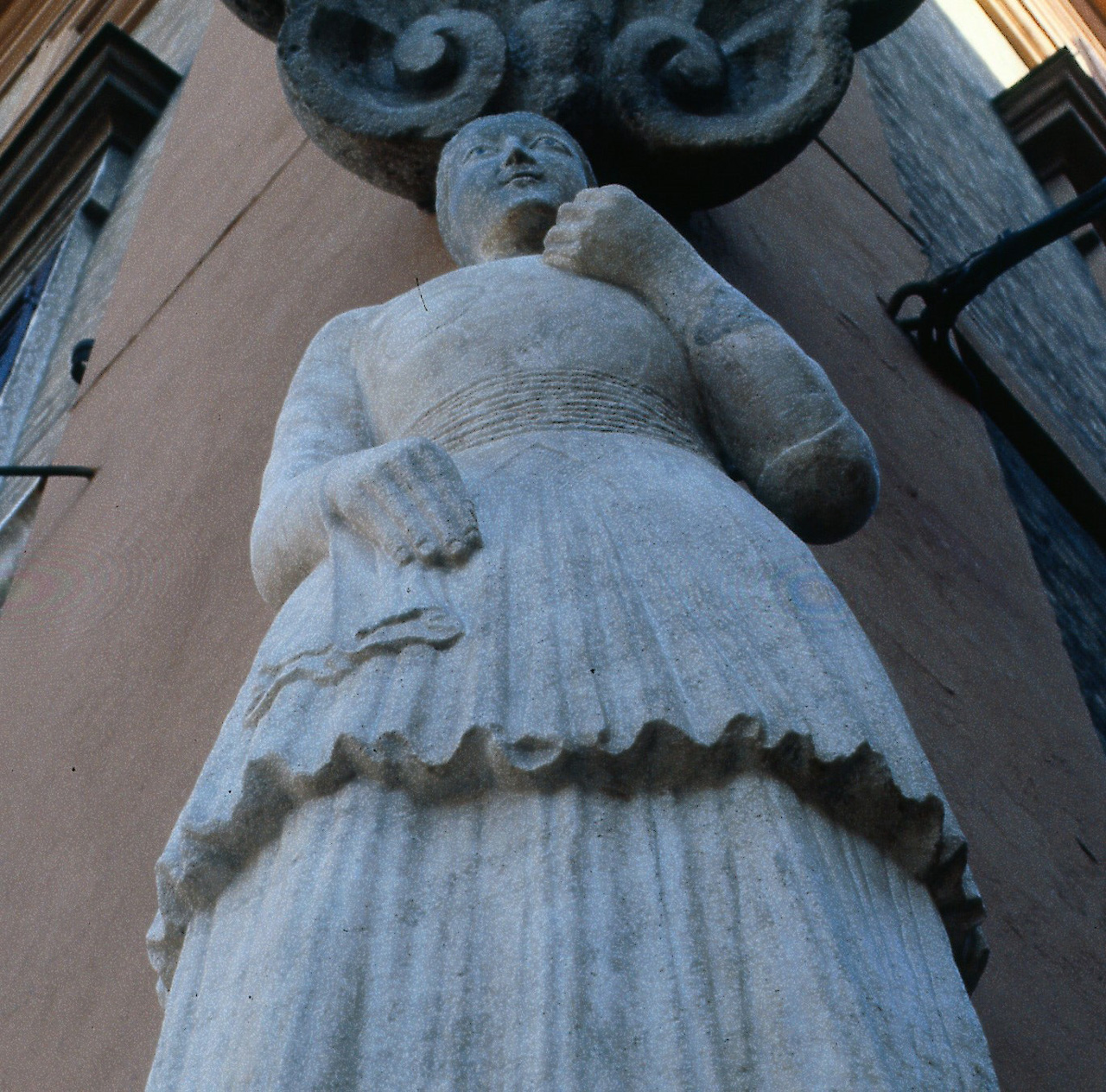
From the Middle Ages to 1600
Statua della Bonissima 2
La statua della Bonissima, XII - XIII sec.
-
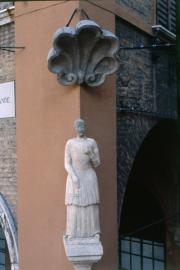
Statua della Bonissima 2
La statua della Bonissima, XII - XIII sec.
-
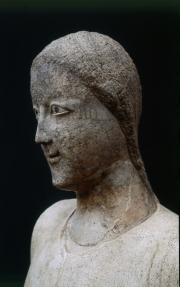
Statua della Bonissima 1
La statua della Bonissima, XII - XIII sec., part.
-
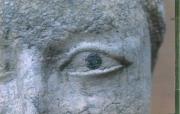
Statua della Bonissima particolare
La statua della Bonissima, XII - XIII sec., part.
-

Statua della Bonissima 3
La statua della Bonissima, XII - XIII sec., part.
-
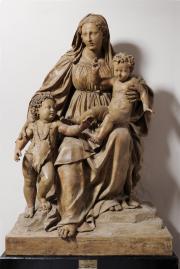
Antonio Begarelli Madonna di Piazza 2
Antonio Begarelli, Madonna di Piazza, terracotta, 1522, Museo Civico
-
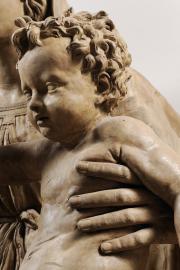
Antonio Begarelli Madonna di Piazza 3
Antonio Begarelli, Madonna di Piazza, terracotta, 1522, Museo Civico, part.
-
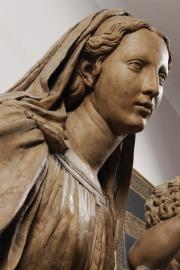
Antonio Begarelli Madonna di Piazza 1
Antonio Begarelli, Madonna di Piazza, terracotta, 1522, Museo Civico, part.
-
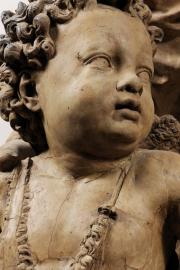
Antonio Begarelli Madonna di Piazza 5
Antonio Begarelli, Madonna di Piazza, terracotta, 1522, Museo Civico, part.
-
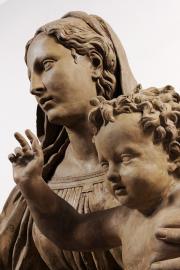
Antonio Begarelli Madonna di Piazza 4
Antonio Begarelli, Madonna di Piazza, terracotta, 1522, Museo Civico, part.
-
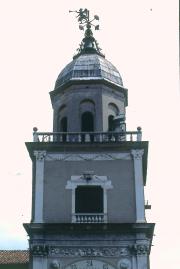
Torre Orologio Leonardi
Bartolomeo Bonascia, Cupolino della Torre dell'Orologio, 1508
-

Banderuola Leonardi 1
Bartolomeo Bonascia, Cupolino della Torre dell'Orologio, 1508
-
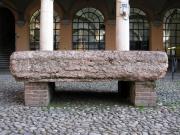
Pietra Ringadora
La Pietra Ringadora
The City Hall as we know it today did not exist in medieval times: it is in fact the result of the incorporation of eight buildings dating from different periods. Documentary evidence shows that in 1046 an earlier town hall or, Palacio urbis Mutinae, already stood on the east side of the square, with the old Civic Tower today known as the Torre Mozza probably dating from the same period. The residence of the Imperial Vicar, Palatium Vetus, although separate from the other buildings, dates from 1194, as can be seen from a carved slab now housed in Modena’s Estense Lapidary Museum. The Palatium Novum, Palazzo della Ragione or dei Notai, Palazzo a levante dell’Arengario, Palazzo della Spelta and finally the residence of the House of Este, the Palazzo del Marchese (1439), were all soon added. Two symbols of the City of Modena date from this phase: the Statue of the Bonissima and the Pietra Ringadora. The Renaissance period saw extensive work carried out on the side of the building overlooking Piazza Grande, including the building of the central Clock Tower and the placing of the statue of the Madonna and Child with the Infant Saint John the Baptist, known as the “Madonna of the Square”, by Antonio Begarelli.
The Statue of the Bonissima
The Bonissima is an unusual statue set on a modillion at the corner of the City Hall at the beginning of the old Via Castellaro. It shows a woman simply dressed in medieval costume with a long plait falling on her shoulder. There are a number of theories regarding the statue. The most likely holds that she is the emblem of the municipal institution of the Bona Estima or Ufficio delle Bollette (civic magistracy), once located at the centre of the square behind the apses of the Cathedral. According to tradition, the statue was erected in the 13th century in honour of a wealthy lady named Bona, who provided the citizens with generous amounts of money to buy wheat in times of famine. Others see the Bonissima as the Countess Matilda of Canossa, who played an important part in the building of the Romanesque cathedral.
The Pietra Ringadora
This is a large rectangular block of red Verona marble placed close to the portico of the City Hall, opposite the steps of the entranceway. In common speech the name means “speaking stone”, since it served as a tribune and pulpit for city orators who in medieval times addressed public gatherings of citizens. By the 15th century it had long lost its original function and began to be used as a “stone of shame” and a warning of severe mercantile sanctions: indeed, city records describe the exemplary punishments meted out upon the stone not only to insolvent debtors, but also to blasphemers. The bodies of those who drowned in the city’s many canals were also laid on this stone for identification or while the guilty were being searched for in cases of suspected murder.
The Clock Tower
An old Arengario del Popolo (City Hall), the tower took on its present-day appearance between the end of the 15th and the beginning of the 16th centuries to house the new civic clock and the bell moved from the adjacent Torre Mozza (today the Civic Museum), which was damaged in the earthquake of 1501 and later demolished. During this phase, the octagonal dome (1508) was added, designed by Bartolomeo Bonascia and crowned by a weathervane with a trumpeting angel, as well as elegant marble decorations of the four orders and belt courses by Ambrogio Tagliapietra.
The “Madonna of the Square”
The Madonna and Child with the Infant Saint John the Baptist by Antonio Begarelli, better known among local residents as the “Madonna of the Square”, owes its name to its original location in a niche next to the Clock Tower, where it was placed in 1528. From 1574 on, the city authorities decided to light the statues with two torches every evening for the benefit of those congregating to recite the Ave Maria. During the French Revolution, the group was taken down and moved a number of times before finally being placed in a hall of the Civic Museum in 1886, where it is still on display today. The young Begarelli used terracotta as his material, originally painted a milky white colour to make it resemble marble, embellished with gilded profiles.